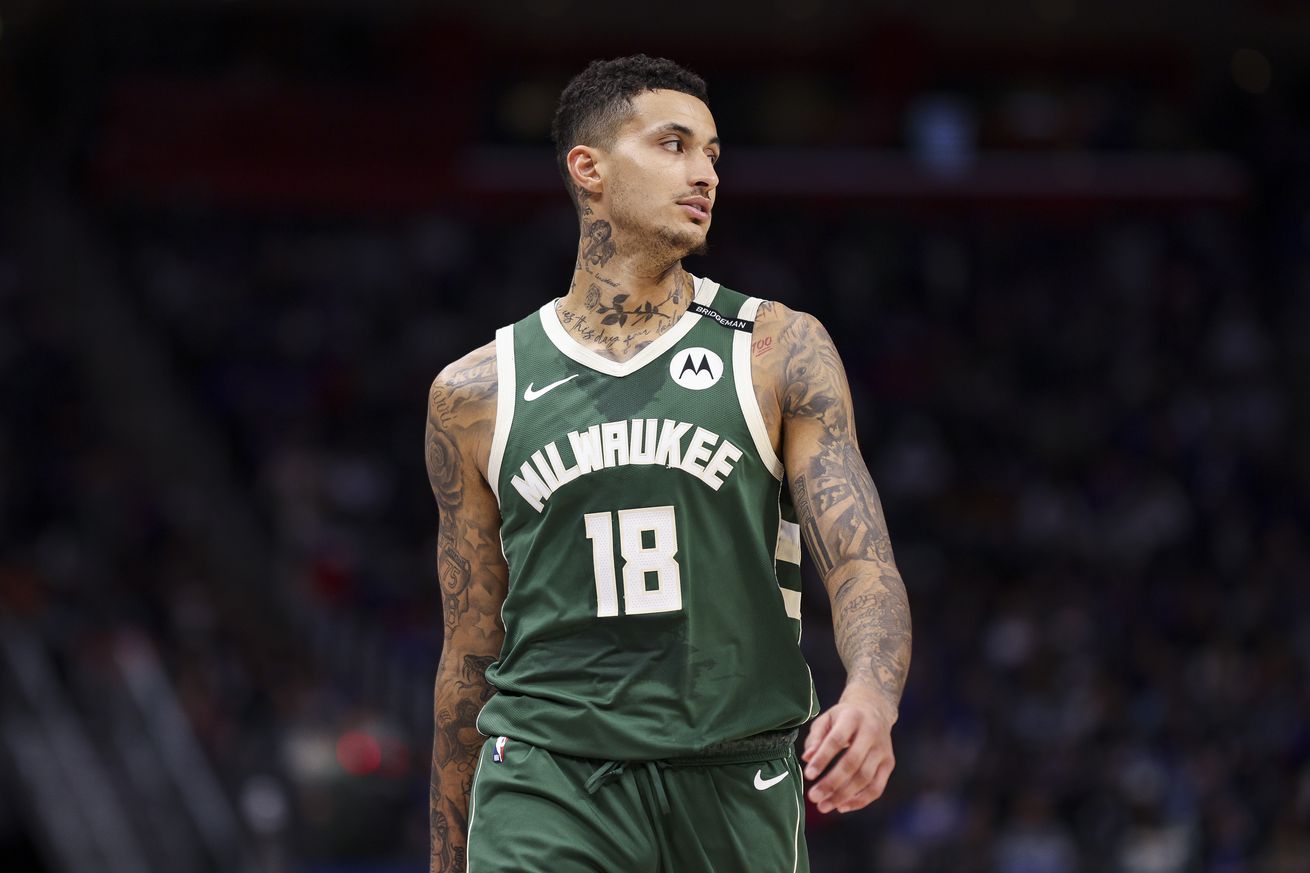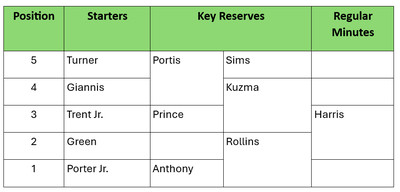
You asked the questions, here are the antlers
Alright, this one was fun—and a little intimidating. Brew Hoopers, you certainly tossed up some lobs. Let’s see if I can throw them down.
Kuzma, Kuzma, Kuzma
aguynamedjr asks: To what degree was Kuzma’s half season with the Bucks last year an outlier… and with a full training camp can they incorporate him better and utilize his strengths while minimizing his weaknesses?
I’ll start by saying I was supportive of the trade that brought Kyle Kuzma to the Bucks. For the record, Khris Middleton will forever be one of my favourite Bucks and absolutely deserves to have his jersey hung in the rafters, but it was clear his body just couldn’t let him do what the team needed over the last couple of years (at least not for prolonged periods). The move also gave the team flexibility that has shaped the roster into what it is now. This said, it’s hard to call Kuzma’s half-season with the Bucks an outlier. Offensively, he shot the ball as he always has:
- 46% from the field with the Bucks vs 45% for his career.
- 33% from three (career 33%).
- 54% true shooting (career 54%).
Notably, however, after shooting just 43% overall and 28% from three over his first 17 games as a Buck, Kuzma shot 49% overall and 37% from three in the final 16 regular-season games. If nothing else (and playoffs aside), there’s at least some hope in that.
Defensively, Kuzma’s rebounding went the opposite direction. After hitting the boards early for the Bucks, grabbing 7.0 RPG across those initial 17 games, this dropped to just 4.1 RPG over the final 16 games of the regular season. Overall, his defensive rating with Milwaukee was 114.0—sitting comfortably between his career best (105.2 with the Lakers in 2019—2020) and career worst (120.8 with the Wizards in 2023–24). Again, there’s at least something in this that suggests under the right circumstances (i.e., a strong defensive team) Kuzma can be positively impactful.
Taking this all into consideration, I think Kuzma is who he is—someone who can get hot offensively and adds some value with his athleticism and versatility, but too often clanks it off the rim or makes ill-advised decisions trying to do too much. To me, this sounds like a rotational player who has to come off the bench. More importantly, does it to Doc? For more on optimizing Kuzma, read here.
Jman2926 asks: Horst said that they want Kuz to play more minutes at the four. Would this mean he comes off the bench or moves from the 3 to 4 when Gianni’s sits?
Tao~of~Hoop asks: What is Kuzma’s best avenue to contributing to this team (provided he’s not traded)? Obviously there are only so many minutes at the 4 with Giannis around, and he’s been a below average shooter and overall very inefficient playing the 3. Sounds like he’s been working on his game, do you think he can be a serviceable starting SF?
As I wrote above, I feel Kuzma has to come off the bench for this team to be most successful. There, he can play the non-Giannis minutes at the four and hopefully find more success against lesser talent. Playing well in this role would be beneficial all-around, helping Kuzma secure more playing time, increasing his trade value, and reducing Giannis’ minutes—a must considering the load he’ll be shouldering. As far as playing the three, I’m sure Kuzma will get minutes there, considering the team’s lack of bigger wings, but I hope this will be situational.
naveed211 asks: What progress has been made toward a Kuzma trade?
While everyone (including this writer) has been clamouring for a Kuzma trade, I presume he will be with the team to start the season and Jon Horst’s recent comments to The Athletic’s Eric Nehm indicate as much (even if this was just posturing). The reality is that Kuzma’s play, primarily in the postseason, plummeted his trade value so much that it would likely take assets just to move him. While I’m open to doing this, it absolutely must be for the right player, and the trade deadline might offer more options than there are now. In the interim, hopefully Kuzma (and Doc) can find a role that both helps the team and restores some value.
Depth and lineups
4Reggie asks: if Doc and Jon are serious about playing fast, pressuring full court, and increasing 3 point volume, I think their best chance is to be going 9, 10, or 11 deep every other game and overwhelming teams with fresh legs. Am I giving Doc too much credit at trying to be innovative?
Southern Marxist2 asks: How many Bucks will play meaningful minutes usually? Do you think Giannis will average greater than 32.0 minutes per game?
I think the roster speaks to this intention. Doc has to have noticed what Indiana did to them the past two years—not to mention the ever-increasing league-wide pace and space trends—and with so many players with the ability to contribute, it just seems logical. I see the regular rotation as something like this:

This depth and youth should enable high-intensity, faster-paced basketball on both sides of the court. Plus, with the similar talent level across the roster, there should be plenty of internal competition, which is always a good thing—it’s not as if there are a bunch of players who warrant minutes based solely on reputation. I look forward to seeing who earns them. As for Giannis, 32 minutes per game would be a nice sweet spot.
DonVinchi2 asks: Would this be a good starting lineup? CA, KPJ, GTJ, GA, MT
While this might be the most dynamic line-up (shout-out to naveed211) that the Bucks could put out in terms of a collection of individuals who can flat-out create offensively (though Portis is better than Turner at this), I feel it is a redundant use of resources. The Bucks have four ball-handlers—Giannis, Kevin Porter Jr., Cole Anthony, and Ryan Rollins—who I’m comfortable with against ball pressure. Having three of these in at the same time turns at least one of them into an off-ball catch-and-shoot type. While Anthony and Porter Jr. can do this to some extent, I’d much rather start AJ Green, who has significantly greater shooting gravity and is also more switchable than Anthony defensively. This gives the starting line-up a bit more size too, and would enable Anthony and Rollins to split second-unit ball-handling duties. I see them complementing each other well there.
Stepping up
DonVinchi2 asks: Who’s gonna step up to the plate this season? Will it be KPJ, Green, Portis, Trent, or Turner?
All of the above! I’m very much in the “let’s do-it-by-committee” camp, where the second-best player can be any one of these guys (or even Anthony or Kuzma) on a given night. Across the season, I’d wager Trent Jr. and Porter Jr. will have the second and third highest points per game average, as they can create their own shots more than, say, Myles Turner (who will likely be as important, if not more, overall). Honestly, the committee approach bodes well for unpredictability and camaraderie—to echo Hear District’s Kris Johnson, there’s something about this team that has me juiced.
The defense
Air Giannis asks: My biggest question with our recent injection of youth (relative to Brook leaving and Turner replacing him) is how exactly our defense will change? The drop started to get figured out and exploited by faster and high IQ players. How exactly will Turner being the anchor change our defense?
This one intrigues me the most. Theoretically, Turner steps into Brook Lopez’s void and offers the same as what he did—elite rim protection—with improved mobility, which should enable him to be more effective on switches and when isolated. Overall, I actually think the drop being “figured out” had less to do with Lopez and more to do with the changes to the team’s perimeter defenders. Losing Jrue Holiday, among others, hurt more than anyone has properly acknowledged. Playing Prince out of position didn’t help either. Now, with more solid (if not plus) perimeter defenders, especially ones with more speed and athleticism, I foresee the drop—should the team continue to use it—to return to its more effective ways. On the other hand, the Indiana Pacers found success pressuring full court, denying the ball, and getting through screens (dare I say, energy and effort?). A blend of the two, including some of the zone that proved effective at times last year, should give the team enough options to make life difficult for opposing offenses. I, for one, am ready to welcome a return to the gritty defensive identity that made Bucks basketball so successful—and fun to watch!
Nano606 asks: Who are going to be our point of attack defenders?
naveed211 asks: My question is can our defense at the point of attack help them enough for us to be a good defense overall.
My starting line-up features Porter Jr., Trent Jr., and Green. While none of these guys are lock-down, All-Defensive types, they can all hold their own—their respective defensive ratings were 108.0, 114.0, and 107.6. For comparison, Derrick White’s was 109.5 and Lu Dort’s was 107.3. Off the bench, Ryan Rollins (108.6)—with his 6-foot-10 wingspan and athleticism—has the best physical attributes to become a lock-down point of attack defender, and I’m excited to see how he follows up a semi-breakout 2024–2025 season. Jon Horst’s recent comparison of Rollins to George Hill just seems so perfect—both in archetype and for the Bucks’ future. I’m excited! Either way, the starting line-up doesn’t project to have anyone that opposing defences can hunt, meaning the team shouldn’t be exposed by the need to over-help as frequently as it has in years past. In brief, I see defensive symbiosis being more important to the team’s defensive success than a single point of attack defender.
Looking forward: picks and extensions
Ham Slamwich asks: We don’t own a second round pick until 2099. What is the history of buying second round picks? Are there trends? Historic hits?
I couldn’t help laugh at the first part of this—the asset cupboard certainly is bare. Trading cash for second-round picks is relatively common, but often happens as part of larger deals involving other picks and/or players. Teams are also limited by the annual cash cap ($7M in the 2024–2025 season). As far as the Bucks go, they traded the 38th pick in the 2016 draft (eventual three-time champ Patrick McCaw) for $2.4M. League-wide, more notable hits include:
- Kyle Korver (51st pick)—the famous copy machine tale!
- Marcin Gortat (57th pick)
- Jordan Clarkson (46th pick)
- Darrell Arthur (27th pick—not technically a second-round pick).
So, this is a possibility, but the Bucks’ recent draft history doesn’t offer a ton of optimism for this strategy. Having said this, could you imagine if a bought second-rounder found another Malcolm Brogdon or Luc Richard Mbah a Moute? Here’s hoping Bogoljub Markovič’s return to Europe can help him evolve into Ersan Ilyasova.
Marcus.Aurelius asks: What’s the best case “win/win” scenario for extending AJ Green? He wants to stay with MKE, but we’re likely looking for a discount.
The best case is Green signing a long-term, team-friendly deal that looks even better after he seizes a starting position and has a career year. That is, get it done now, Horst. My thoughts on what this might look like, including deals similar players have received, can be found here.
So, what do you think—did I flush them home or clank them off iron?
